
The structure of the mucous membrane of the olfactory organ is arranged according to the functions performed. In his cavity gets air, which must go through moisturizing, purification and heating. To ensure that the heating was carried out very quickly, there are vessels on the mucous membrane. They are located very close to its surface. So with the slightest damage to the mucosa, blood loss from the nose occurs. This phenomenon has become widespread not only among adults, but also children. Let us dwell on this in more detail.
Content
- 1 reasons
- 1.1 Colds
- 1.2 Injuries
- 1.3 Frequent use of vasoconstrictive drops
- 1.4 Frequent use tampons
- 1.5 Pathology
- 1.6 Too dry air
- 1.7 Tumors
- 1.8 hormonal failure
- 1.9 Diseases of theand systems
- 1.10 External causes
- 1.11 Sneezing and coughing
- 2 How to treat
- 3 Komarovsky's opinion
Reasons for
To prescribe an effective treatment for butbleeding in a child, the doctor must first determine the provoking factor.
Catarrhal diseases
Certain types of virus are deposited on the mucous membrane of the nasal cavity. It is for this reason that the inflammatory process develops. As a result, the nasal mucosa undergoes loosening, and the capillaries move to the surface and begin to secrete blood. So, with a cold, a cold in children, blood loss from the nose is a frequent occurrence. 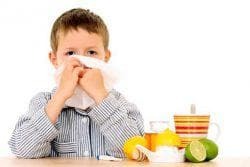
Injuries
Children very often climb in the nose with their fingers. This breaks the integrity of the nasal mucosa. Another impact on the violation of its integrity can be a blow to the nose. In this case, the children of the red liquid from the olfactory organ may not necessarily appear during a strong impact. It is easy enough to touch it. Provoke a blood discharge can a foreign object that is in the nose.
Frequent use of vasoconstrictive drops
Unfortunately, parents forget that the use of vasoconstrictive drops can not last longer than 7 days. If they dribble their nose in the child longer, the mucous membrane becomes atrophied, thinner and becomes sensitive to trauma.
Frequent use of tampons
In this case, there are a number of ambiguities. For example, when bleeding parents most often use a cotton swab, installed in the nasal passage, to stop blood loss. There is a narrowing of the vessels. They are adjacent to cartilage and bones, and the bloodstream is blocked. Thus, it is possible to stop bleeding. 
If tampons are often used, the mucosa gets insufficient nutrients and atrophies. In this case, she is even more prone to injury. In order not to use tampons often to stop bleeding, you need to see a doctor as soon as possible for help.
Pathologies
There are a number of pathological processes that can be both congenital and acquired, leading to changes in the coagulating lymphatic system. May appear in small, year-old children, and older children( 2, 3, 4, 5, 6, 7, 8, 9, 10 years and older) 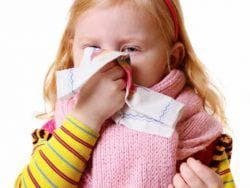
Thus, the duration of bleeding increases, even with a small damage to the capillariesthe child runs blood from the nose. There is no blood clotting, the wall of the vessels is inflamed and poorly healed. In small patients, repeated blood loss from the nose often occurs.
Too dry air
If the room is dry air, then this leads to the fact that the mucosa is all the time overdried. There is a risk of atrophy and increased damage. And this, as is known, leads to the development of bleeding.
Tumors of
Often in children in the body cavity of the olfactory with frequent bleeding diagnosed polyps. These growths are formed where there are blood vessels. Over time, the tumor becomes smaller and may disappear. 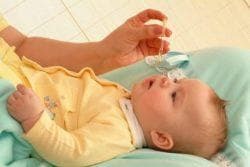
But there are cases when the growths grow and begin to bleed. In adolescence, a child with nasal blood loss can diagnose angiofibroma. This is a benign tumor that forms from the vessels and connective tissue.
Hormonal failure
Adolescents have an increased production of hormones. This helps increase the pressure of lymph in the vessels, swelling of the mucous membrane and the appearance of bloody discharge.
Diseases of organs and systems
Often the pathologies of other organs and systems lead to a reduced coagulation of lymph. This entails the development of bleeding from the olfactory organ and other organs. There is a similar condition in hepatitis, anemia and hypovitaminosis. 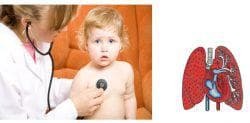
External causes of
Red nose fluid in children can go as a result of the harmful effects of radiation, sun, chemicals. For such an effect the body responds with a nosebleed.
Sneezing and coughing
Bloody capillaries in children have a small thickness, so that with a sudden increase in pressure inside them they are destroyed. This occurs mainly when coughing, sneezing. The result is bleeding from the nose.
On video, why the child has nose blood:
How to treat
Bloody discharge from the nose in a child can begin at the most inopportune moment. With regard to treatment, it should appoint a doctor in accordance with the established diagnosis. But there are a number of recommendations that parents should know if their child has nose bleeding:
- Calm the child, seat him and tilt his head up .In most cases, the capillary bleeding does not make itself felt in a few minutes.
- Take the first aid kit and put in your nose cotton swabs soaked in perhydrol. In doing so, you need to do this extremely accurately, not pushing tampons too deep. This can disrupt the integrity of the capillaries and the bones of the nose. If there was no cotton wool at hand, then you can pinch your nose with your fingers for 5-10 minutes.
- Place a cold towel or ice pack on the forehead and nose bridge area.
- It is not possible for the child to take a horizontal position or tilt his head back strongly. This will cause the blood to move along the nasopharynx into the esophagus. Also it is not recommended to move, talk and blow your nose.
Stop bleeding should occur in 10-20 minutes. If this did not happen and the blood goes on for a long time, then it is necessary to call an ambulance.
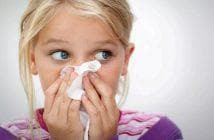 For those who want to learn about how to stop the blood from the nose in a child, you should go to the link and read the contents of this article.
For those who want to learn about how to stop the blood from the nose in a child, you should go to the link and read the contents of this article.
And that's why at the temperature there is blood from the nose and how this problem can be handled, is described in this article.
Why a teenager has blood from the nose and what are the main reasons that can cause this problem, this article will help to understand: http: //prolor.ru/n/simptomy/ pochemu-idet-krov-iz-nosa-u-podrostka.html
And that's why blood can go from the nose andwhat the main reasons contribute to this problem, will help to understand this article.
Opinion of Komarovsky
According to the famous pediatrician Komarovsky, the main cause of bleeding from the nose in children are the features of the structure of the nasal mucosa. It is because of them that blood loss occurs. But the most frequent provoking factor in the opinion of the doctor is dry air in the room in which the child is. Namely, because of the dryness in the air, the nasal mucosa dries up, the crusts form, and when they are removed from the child, blood is extracted.
Komarowski emphasizes bleeding that does not involve injury. As a rule, dry air provokes those bleedings that occur suddenly, for no apparent reason.
On the video view of Komarovsky:
If a child has a red liquid from the nose, then the parents should act as follows:
- Seat the child so that its body is tilted forward. In this case, the head should be focused straight or slightly tilted forward.
- The baby's nostrils squeeze your fingers for 10 minutes. Breathing in this baby should be carried out by mouth.
You may also be interested in learning about what to do when your nose is not breathing at all.
What to do when the rhinitis is not present, and the nose does not breathe, and what means will help with this problem, is described in this article. And here's what to do. When the nose does not breathe, and drops do not help, it is told in this article.
What to do first, when a child is breathing heavily with his nose but there is no snot, and what medicines should be used first, is described in this article.
than to treat, when a child does not breathe a nose and what medicines should be used first, is described in this article.
Bleeding from the nasal cavity of a child can provoke any factor. The main thing is to find it on time and send all the medical measures to eliminate it. Otherwise, bleeding from the nose will periodically occur and frighten the child, because even to minor blood loss, children react painfully.
